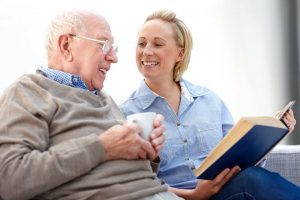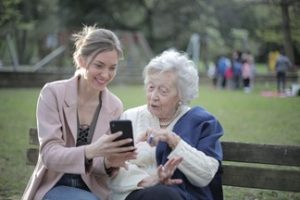Guest Blog: Hiring an In-Home Caregiver: What You Need to Know
When looking for an in-home caregiver for your loved one, it’s a given you would prefer someone they can get along with really well and will do a great job of taking care of them. However, finding this home care option for your senior loved one can be challenging at times.
Fortunately, there is no shortage of tips you can follow to ensure you find the perfect person for the job. The following tips should get your search off to a fantastic start:
Create a clear job description
To come up with a clear job description, identify what your elderly loved one’s needs are. A clear and specific job description can help you determine the flexibility needed, the number of hours they’ll be looking after your loved one, and how much you are likely to pay.
Be flexible when hiring independently
If you want to find great candidates, you need to be flexible about the pay. It is also recommended that you offer the going rate in your area. Otherwise, you might not find applicants with the care skills you are looking for.
Conduct multiple interviews and a trial period
To get more insights about a candidate, consider conducting three interviews:
- A short screening interview over the phone to ensure they meet the necessary requirements.
- An in-person interview if they pass the phone screening.
- An in-person interview where the top 2 candidates can also meet your elderly loved one.
Ask all the important questions during the interview
Asking all the right questions can help you find someone responsible, compassionate, and trustworthy. It would also be a good idea to ask what they’ll do in a specific situation. For instance, what they would do if your elderly loved one refuses medications or does not cooperate.
Check their references
Even if you find a candidate very impressive, it is ideal that you still do a background check. You can do this by calling the work references they have provided. You can ask if they do a good job and if they’ll hire the candidate again.
Conclusion
While finding the best in-home caregiver can be challenging, it can be done. As long as you prepare accordingly and cover all the essential bases, you’ll find the right person for the job with ease.
Guest Blog: How Electronic Health Care Is Better For You
Did you know that your health information is as personal and sensitive as your medical records? Did you also know that anyone could access this information online, even if it’s not public yet? If you or a loved one has been in the hospital recently, or has had any tests done, there’s a good chance you have private patient information available to view on the Internet. This information may be accessible because healthcare institutions often do not protect patient data with security measures. Many hospitals, clinics and medical offices are not safeguarding patients’ electronic health records (EHRs) with password protections and other security features. As a result, hackers can easily access this information without permission. In this blog post, we will explain everything you need to know about being cautious of your health care data.
What is Electronic Health Information?
Electronic health information (EHI) is the data that is created and maintained in digital format by physicians, hospitals and others who provide health care. This includes all health-related instructions, observations, diagnoses, allergies, procedures and any other information providers write into patients’ medical records like diet plan for diabetic patient etc. EHI can include demographic information, medical histories, test results, medications, allergies and even lab-drawn blood-type.
Why Is Electronic Health Information so Important?
Electronic health records (EHRs) are digital records that keep track of your medical history. They contain information from your doctor visits, hospital stays, tests and more. The EHR system was created to help physicians provide better care and better understand your medical history. The system also allows for easier record-keeping for all parties involved in your care. EHRs can help you get the best care from your doctor because doctors can access your entire health history. They can also help you get better care if you go to a different doctor by providing your entire medical history to them. EHRs can also help you take better care of yourself because you can view your entire medical history online at any time. You can also print out information to bring to your doctor’s appointments.
Why is your Electronic Health Information Important?
Your health information is an extremely sensitive and important part of your life. It includes all of the details related to your health, treatments and conditions. Your health information is subject to specific privacy laws that are designed to protect your information. If anyone (including a doctor or an insurance company) were to view or misuse your information, it could be extremely harmful. Your health information is important to you personally and financially. For example, it can help you get the care you need like IVF treatment etc, keep you covered by health insurance, and manage your overall health. In addition, if you share your information with others, it could help them provide better care for you. It could also help them better understand you and your medical history.
How You Can Find & View Your Own Electronic Health Record
You can find your own EHR on websites such as HealthHound, or web portals such as Google Health. You can also ask your health care provider or insurance company if they have a portal where you can view your own EHR. If you want to see your medical records in person, you may be able to do so at a medical office or clinic. Depending on where you live, you may also be able to request to view your EHR through government websites, such as the Health Insurance Portability and Accountability Act (HIPAA) website.
3 Ways that People Might Be Seeing Your Private Healthcare Data Online
If you or a loved one has been in the hospital recently, or has had any tests done, there’s a good chance you have private patient information available to view on the Internet. This information may be accessible because healthcare institutions often do not protect patient data with security measures. Hackers can easily access this information without permission. They can also sell this data to unscrupulous individuals or companies. In this case, people might be able to access your private information through nefarious websites such as Facebook Marketplace or Craigslist. People or organizations can also breach healthcare data through hacking. Many hospitals, clinics and medical offices are not safeguarding patients’ EHRs with password protections and other security features. As a result, hackers can breach the data remotely and access private information.
What Should You Do if You See a Breached Record of Yourself?
If you see your own EHR on a website you should report it immediately. You can also contact your doctor’s office and ask them to report it. You should also contact the website administrator or the hosting company and ask them to remove your medical information.
Conclusion
Depending on where you live and where you receive medical care, your medical records may be online. If you ever have a serious medical condition, it’s likely that a doctor will write your information into an electronic health record (EHR). This means that your information is also on the internet, even if you don’t see it. You may be able to access and view your own EHR through commercial websites or portals. If you ever see your own EHR online, you should report it immediately. You can also contact your doctor’s office and ask them to report it. You should also contact the website administrator or the hosting company and ask them to remove your medical information
Five Eye Health Tips for Maintaining Long-Life Vision
As you age, so do your eyes. It is a simple fact of life, however, age related vision problems don’t need to be a lifestyle changer. Knowing what’s to come and how you can maintain your vision for the long haul is an essential first step, according to the American Optometric Association.
As you approach 60 years young, it is vital to pay more attention to the warning signs of age-related vision issues. Vision problems as you get older can be acute or chronic, but knowing how to steer clear of them is probably at the top of your list.
Making significant lifestyle choices and getting regular eye exams will help keep you focused on your eye health. Let’s face it, visiting your optometrist is more fun than seeing your dentist or primary physician. Let’s take a look at a few ways you can keep your vision strong, no matter your age.
- Visit Your Eye Doctor Regularly for Optimal Eye Health
There are some pretty unfavorable eye diseases you may be at risk for, especially if you skip your eye exams. In order to keep your vision as keen as a 20 year olds, visiting your optometrist regularly is vital.
In fact, an article published in academic journal, American Family Physician (1999) found several common causes of vision loss in the elderly. The vision debilitating eye diseases you may be at risk for include Macular Degeneration, Glaucoma, Cataracts, and Diabetic Retinopathy, among others. Seeing your eye doctor will help you avoid these chronic vision loss conditions.
- Eat Right to See Right
What you eat directly affects your health. And the same applies for your eye health. Eating the healthy nutritious meals at least three times per day is one exceptional way to keep your focus on great vision.
Food loaded with nutrient rich vitamins and minerals, such as omega-3 fatty acids, lutein, zinc, and vitamin C, and vitamin E may help keep your eyes in superb shape. Those greens, eggs, nuts, and salmon are a great place to begin. You may even see a few pounds shrink away from your waist.
- Focus on Eye Health and Quit Smoking
Saving your lungs from smoking is also saving your vision from acute and chronic vision issues in the future. In fact, smoking increases your risk for cataracts, optic nerve damage, and macular degeneration.
If quitting your attempt to quit smoking continues to happen, don’t give up. Your vision as you age may depend on it. And if you quit smoking, you will most likely live longer, making it even more imperative to have great vision to see your grandchildren blossom.
- Look Cool and Protect Your Eyes with UV Sunglasses
If keeping your eyes healthy aligns with your fashion, even better. Wearing UV sunglasses may help protect your eyes from the sun’s powerful rays. Research suggests that too much UV exposure will increase your risk for cataracts and macular degeneration.
Pick up some sunglasses with 99% to 100% of both UVA and UVB rays. Protecting your peripheral vision is also important, so wraparound shades may be even better. There are even contacts with UV protection these days. However, sunglasses with UV block are best.
- Limit Your Screen Time for Better Vision Later in Life
Limiting your screen time is nothing new. In fact, mothers have been saying television ruins eyes for decades. If you want to protect your eyes, taking a break from so much screen time is essential.
This also extends to tech devices such as smartphones, tablets, and laptops. The American Macular Degeneration Foundation suggests that the blue light emitted by these tech screens may trigger macular degeneration, among other health issues.
Protecting your eyes today may pay off big time as you begin reaching those golden years. And it is never too late to start living healthy to improve your vision. Most of the suggestions made by professionals can also make a big impact on your overall health. Stay focused when it comes to eye health, because seeing is an important sense to maintain forever.
Guest Blog: Health advise for patients using CBD oils for anxiety.
Like many mental disorders, anxiety can be very annoying to deal with and affect our everyday lives. There are many different cures and remedies people use to deal with anxiety and lower its impact. CBD oils have proven to be very effective against anxiety, but their usage isn’t as widespread as other substances.
For people who opt for CBD oils, there are some crucial things to remember regarding how they affect our bodies. We will look at the positive effects of using CBD oils and the side effects that are generally associated with the usage of CBD oils.
What exactly is CBD oil?
CBD oil stands for cannabidiol oil, and it comes from the cannabis plant. CBD oil is made by extracting CBD from cannabis plants and mixing it with something like hemp seed oil to dilute it.
Most of us know cannabis as a substance with mind-altering properties. The sensation of getting high comes from THC in the cannabis plant, which is a psychoactive cannabinoid. CBD oil and CBD oil products don’t have the same properties that can make a person high, making them safer for consumption.
Different people like to consume CBD oil in different ways. CBD oil can come in the form of dietary supplements or in the shape of something like gummies. Some people prefer consuming CBD oil through some drink like tea.
CBD oil in dealing with anxiety
Researchers have found CBD oils to be very effective in dealing with anxiety. The oil has many qualities that make it ideal for people who often suffer from anxiety. For people who are recovering addicts and feel anxious most of the time, CBD oils are very good in alleviating a lot of your symptoms.
The amount that you should use can differ from person to person. It is recommended that you talk to your doctor before CBD usage, especially if you have other health risks.
Many other benefits
There are also many other benefits of CBD oil usage. Not only do they calm your brain and help in dealing with anxiety, but CBD oils are also great in dealing with pain relief and sleep disorders. Some researchers have also found that CBD oils can help lower the chances of cancer and heart disease.
Side effects of CBD consumption
Despite all the positives associated with CBD consumption, there are some negatives you should be wary about before using CBD oil or CBD oil products. The most common side effects of CBD are:
- Fatigue
- Change in appetite: some people feel increased hunger, and others don’t feel like eating at all.
- Weight loss: some people encountered random weight loss from CBD consumption
- Diarrheic
Everyone does not feel these symptoms, but there have been cases where people have felt these to an extreme. Other than these symptoms, some people also encounter drowsiness from CBD oils.
Alternatives to CBD oil
CBD oils are recommended to be consumed in small doses regularly for effective long-term results. For many people, CBD might not be very effective and they might look for a different type or remedy. Kratom is a plant that, like CBD, is very effective against anxiety and other mental disorders. Ethnobotany is humans’ relation to plants in their locality, and both ethnobotanicals Kratom and CBD have benefits associated with consumption.
What makes kratom different is that kratom can be more potent when looking at a single dose and provides more instant relief from anxiety. Kratom consumption is not recommended for longer peridots of time, and it shares many of the adverse side effects of CBD.
Other than that, lifestyle changes are also effective in dealing with anxiety. Exercising more, meditation, and being more social have proven to be very effective against anxiety. Some people might feel stronger symptoms and not be able to function properly. For them, something like CBD or kratom are the obvious choices.
Age of people who use CBD
CBD can be used by any adult that feels like they need it. That being said, for older adults, or people with other health conditions, it is recommended to use less of these substances and consult a doctor before using them. The symptoms older people feel can be much more amplified.
Guest Blog: 5 Reasons Seniors Should Buy Organic Produce
In older age, your body needs nutrition to prevent chronic diseases and deterioration of dental, bone, and joint health. A balanced diet rich in nutrients is essential for heart health, diabetes, and preventing cognitive decline. But as we age, our ability to absorb nutrition from food decreases. And that’s why it’s even more essential to include nutritious food like fruits, vegetables, nuts, legumes, and fortified cereals.
Experts suggest that including organic food in your diet can help the elderly defend their bodies against chronic illnesses and manage any chronic illnesses they may already have. Organic food is easier to digest, doesn’t contain any harmful chemicals, and carries nutrition better than conventional produce.
What is Organic food?
Even though there is no set definition of organic food, it is described chiefly as food made from produce grown without artificial fertilizers, synthetic pesticides, or other chemicals. Organic poultry and meat products are from animals that aren’t given antibiotics or growth hormones.
When growing organic food, farmers use organic pesticides such as manure and compost. Unlike conventional produce, no chemicals are used to boost the size or to ripen organic fruits or vegetables. In many countries, the government has established strict regulations for growing organic produce. To obtain certification, organic online stores and organic product manufacturers must prove that 95% of the ingredients used to create the final product are natural.
How Organic food Keeps Many Diseases Away from the Elderly?
Senior citizens must avoid all foods that can cause side effects to their bodies. Organic food eliminates the possibility of allergic reactions or side effects due to its all-natural origins. Here are some ways in which organic food helps the elderly –
- Organic food has higher nutritional content, including vitamins and minerals. After a certain age, the body absorbs lesser nutrition from food and it is essential to eat food that offers high nutrition.
- Long-term consumption of organic food provides consistent nutrition that helps combat conditions like heart diseases, blood pressure, migraine, and diabetes.
- The absence of toxins such as chemicals, pesticides, and chemical-based fertilizers helps avoid adverse effects on health.
- Healthy organic foods strengthen the body’s immune system and improves skin and hair health.
However, to enjoy all the benefits of organic food, older people must be given food correctly, and the diet must be regulated as advised by their doctor.
Five Benefits of Including Organic produce in Your Diet
- Contains Antioxidants – Organic food contains 18 to 69% more antioxidants than conventionally grown food. Including organic food rich in antioxidants can reduce the risk of cancer, heart disease, vision problems, and cognitive malfunction. Antioxidants are essential to prevent cell damage due to age.
- Less Chance of Food Related Illness – Conventional food may contain pesticides, chemicals, and in the case of meat – even hormones. Such substances may contaminate food, making it unfit for consumption. Such food may cause food-poisoning or other complications in anyone who eats it. Consuming contaminated food is harmful to everyone, especially senior citizens.
- Stronger Immunity – Organic produce grown naturally is rich in vitamins and minerals that boost immunity in humans. Conventional food is grown with chemicals to enhance the quantity of the food while lowering costs. There are many ways to boost immunity and consuming organic foods to boost immune system. It is free from chemicals and naturally enriched with nutrients that build immunity.
- Zero Percent Pesticide Content – Chemical pesticides in conventional produce can slowly erode the body’s natural immunity and strength. Organic food contains zero pesticides and can be consumed worry-free by young children, adults, and senior citizens. Regular consumption of non-organic food can lead to lifestyle diseases, life-threatening diseases, and chronic illnesses.
- Better Taste – When fruits and vegetables are injected with antibiotics or chemicals to help them ripen faster, it adversely affects the taste and aroma of the produce. Organic food is grown with a 100% natural process that preserves the natural taste, texture, and aroma of fruits and vegetables. Even though growing organic fruits and vegetables take longer, the final product tastes much better.
Research has shown that organic food is a healthier, tastier, and safer choice for people of all ages. Various factors are considered when growing organic food, such as soil fertility, the timing of beginning the growth process, irrigation, and manure to fertilize the plants must adhere to a standard of purity. For senior citizens, diet is an essential part of healthcare. By choosing an organic diet, they can ensure they receive the nutrition and care they need at an advanced age.
Author Bio:
Kunal Tambe is part of the content marketing team at Two Brothers Organic Farms. With his team, he works tirelessly to create awareness about organic farming, food sovereignty, sustainable practices, nutrition, climate change and a myriad of issues that surround these topics. His content offers value to farmers, the agriculture industry and to end consumers. Besides writing and developing content strategies, he loves adventure sports and listening to classical music.






